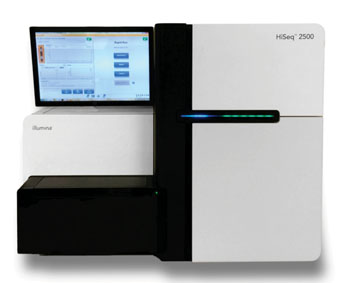Genetic Mutations Linked to Rare Multiple Bowel Tumors
By LabMedica International staff writers
Posted on 28 Jul 2016
Most people with colorectal cancer will develop one primary tumor, which may then multiply and spread; however, in around 2% to 5% of colorectal cancer (CRC) cases, two primary tumors will originate and develop independently, known as synchronous colorectal cancer.Posted on 28 Jul 2016
Genetic mutations have been identified that affect the immune system which may lead to the development of more than one bowel tumor at the same time and understanding how these cancers develop could improve targeting of therapies, but the causes of multiple tumors are still poorly understood.

Image: The HiSeq 2500 sequencing system (Photo courtesy of Illumina).
A large team of scientists led by those at King's College London (UK) and the FIRC Institute of Molecular Oncology, (Milan, Italy) investigated whether the synchronous tumors had the same or different mutations and what genetic alterations could be predisposing people to develop more than one colorectal tumor. They analyzed 20 synchronous colorectal cancers (syCRC) from 10 patients, and compared their genetics to people with only one colorectal cancer and to healthy people.
Tumors used in this study were collected from patients diagnosed with CRC who underwent surgical resection of two syCRC in a window of time of six months maximum. Five mononucleotides were analyzed by capillary gel electrophoresis and used as molecular markers of microsatellite instability in tumors of four patients. A tumor was classified as microsatellite unstable when at least one marker was found altered. Genomic DNA for all tumors, except one patient and seven matched normal tissues was extracted from 10 μm-thick formalin-fixed paraffin embedded (FFPE) sections using QIAamp DNA FFPE Tissue kit (Qiagen, Hilden, Germany). DNA from blood and frozen samples was also extracted. Libraries were sequenced using either HiSeq 2000 or HiSeq 2500 (Illumina, San Diego, CA, USA).
The genetic analysis found the synchronous tumors were not related to each other as they contained a variety of different genetic mutations that had led to cancer. This genetic variation makes synchronous colorectal cancers more difficult to treat, because therapies targeted at specific genetic aberrations in a person's cancer may not work if the other tumor has different genetic mutations. The team also found synchronous colorectal cancer patients had a higher occurrence of inherited damaging mutations in immune-related genes. Three-quarters of synchronous colorectal cancer patients were found to have rare damaging mutations in genes related to immune system function.
These patients had differences in the composition of their gut immune cells, which could lead to inflammation in the gut. The study authors conclude that synchronous colorectal cancer patients have inherited damaging alterations of immune-related genes, which may cause an inflammatory environment in the gut and increase the frequency of independent cancer-initiating events. The study was published on July 5, 2016, in the journal Nature Communications.
Related Links:
King's College London
FIRC Institute of Molecular Oncology
Qiagen
Illumina














